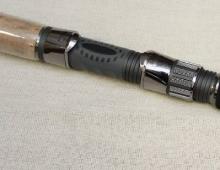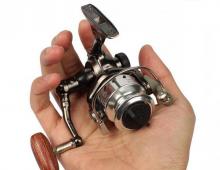Catching a passive pike with a spinning rod on silicone lures
When pike is passive, you have to resort to various tricks both in the silicone baits used and in their installations.
Recently, there has been great popularity edible silicone baits. They have become #1 lures for me and my spinning friends. And this despite the high cost. Against the background of edible silicone, the rest of the silicone baits remain behind the scenes. But don't overlook them. Often there are moments when the same perch actively feeds and keeps in large flocks. In this case, silicone will come to the rescue more durable than edible. But I will tell you, based on my own experience, when the fish is inactive, it is much more difficult to “stir up” it without the use of edible bait. The point, in my opinion, is not even in the most edible silicone, but in its softness, smell and the right size. Attractant and salt are part of the silicone itself. It also means a lot that basically edible silicone baits are made for inactive models (“worms”, slugs, crustaceans, octopuses, etc.), but they can provoke even the most inactive fish to bite. And not only predatory. On edible silicone baits, you can purposefully catch peaceful fish: crucian carp, rudd, etc. But there are also surprises when catching a predator. On one of the last pike fishing trips, carps pecked at edible silicone. There were many bites, and there were gatherings. But we still managed to catch two carps. In the photo, carps are 4.2 kg and 2.8 kg.

Today, when the market is overflowing with an extensive range of edible silicone baits, it's hard not to get confused and get something worthwhile. Unfortunately, not all edible baits fish well. By what signs to determine the quality and catchiness of edible silicone? First of all, these are reviews of comrades who have tried this or that edible bait. But if there are no such people among your acquaintances, then I will give some advice.
So, the first and most important thing when choosing an edible silicone bait is the presence of an attractant and salt in the composition of the silicone itself. Many manufacturers impregnate ready-made silicone bait with various attractants and sprinkle with salt. I call such baits conditionally edible, since both the salt and the attractant are quickly washed off and the silicone must be further lubricated with the attractant. In real edible baits, the attractant and salt are initially added to the composition of the silicone itself. Therefore, they never lose their smell and taste.

The second, no less important, criterion is the presence of sparkles in silicone bait. This component significantly increases the number of bites.
Well, the third criterion is the similarity in size, shape and color of the intended object of hunting pike, perch, etc. These are all kinds of imitations of fry, crustaceans, worms, etc.
Pike loves smooth, unhurried retrieves with a sweeping play of the bait, which hovers above the bottom, slowly moving its tail and creating micro-oscillations. Such fluctuations simply magically affect the hunting instinct of the pike and provoke it to attack. All this is true if you take a twister or vibrotail. Basically, edible silicone, which is really catchy (especially "worms", "crustaceans", slugs, etc.), does not have its own game. Therefore, animation of the lure is necessary, created using spinning and various types of postings. To do this, you need an appropriate spinning kit, but more on that later.
Size and color of silicone bait
Talking about choice silicone lure for pike fishing, I will be based on personal experience that I was lucky to gain in competitions and consolidate in the practice of private fishing, as well as when observing athletes catching pike purposefully. In principle, for pike, the main component is the wiring of the bait itself. Therefore, silicone bait should be chosen so that it is as resistant as possible to breaks on aquatic vegetation, stones, shells. In terms of size, I prefer silicone lures 2-2.5 inches long if the pike is inactive, and larger lures (no more than 10 cm) for active pike in late autumn.
This year I faced a completely incomprehensible situation for me. And if I hadn't tried it myself, I would never have believed it. It turns out that even in muddy water, pike and other predators like dark colors and transparent silicone. Moreover, inclusions of sparkles in silicone of any color dramatically increase the catchability of the bait. Of course, poisonous colors (light green, burning raspberry, etc.) also attract pike, but dark colors (brown, caramel, machine oil, dark purple and even black) attract pike much better during the period of its passivity. And if it is also an edible silicone bait ...

So we are on the water. What to apply in specific conditions at this time of the year? By specific conditions, I mean a body of water with or without flow, its depth, the presence of vegetation on the bottom and surface, and much more. But don't take my advice as a rule. In order to properly mount the tackle, you need to understand the entire upcoming fishing process and, based on this, think about choosing a silicone bait, its loading and wiring. So, let's take as a basis the minimum weight of the jig head. Well, let's say 2-3 gr. In this case, the bait we have is a “worm”, a slug, a “crustacean” or something similar 2–2.5 inches long (5–6.3 cm). With this set, you can comfortably fish at depths from 1 to 3-4 m, depending on the strength of the wind. It will also not be superfluous to add that with a smaller weight of the jig head, there will be more bites.
Conducting silicone bait when catching passive pike
Having decided on the bait (in our case, it is a passive silicone bait), you need to choose the type of wiring. And again, remember and take into account the following: the pike stands in ambush so as to see the future victim from above itself. Hence the priority of a jig head of light weight and, accordingly, the slowest possible wiring. Sometimes drag along the bottom wins, but more acceptable wiring is 5-10 cm from the bottom with smooth pulls and pauses up to 3 seconds. Also, one should not forget that when pike fishing you need to catch a promising place from several points. This will work if you are on a boat. If fishing is carried out from the shore, then try to catch a place at different angles to the shore. Make casts to the left, right, perpendicular to the shore.
When a silicone bait is rigged with an “eared” sinker, the bait acquires a more lively look during the animation process, which, you see, cannot but affect the effectiveness of the fishing itself. And the wiring in this case looks like two or three smooth rises of the tip of the spinning rod from 10 o'clock to 11.30 with the cord winding up. At the same time, during pauses, it is necessary to give slack to the cord and pause after the bait touches the bottom for 2-3 seconds.

But then the water cooled down even more (4–6 C), and the pike began to “act up”. Pike bites became rare or disappeared altogether. There are several explanations for this, as well as ways out of the current situation. The fact is that with the cooling of the water (November - December), the metabolism of pike and other fish slows down. She continues to eat, but not as actively as before, and this cannot be ignored. The pike will no longer chase after a fast-moving bait, but will wait until the prey comes to it on its own or passes by very slowly, with long stops. The wiring can be left the same, but the amplitudes should decrease. The bait should “jump” literally in one place and low (maximum 8–10 cm from the bottom), and at the same time, pauses should increase to 5–8 seconds. For pike, it is better to bait with the same wave-like wiring, but with a smoother and slower amplitude. There are frequent cases of pike biting during a prolonged pause. Well, let's say you got a call, and while you are talking on the phone, the silicone bait lies motionless at the bottom. At this moment, the pike bite occurs.
rigging
For completeness of information, a few words should be said about important details that contribute to an increase in the number of bites of a “sleepy” and cautious predator. And the first thing I would like to say is the use of a piece of fluorocarbon about 1 m long as a leash. The diameter should be selected based on the choice of the object of hunting. If it's perch, I would recommend a 0.14-0.16mm fluorocarbon with a 0.06-0.08mm main line. Of course, when biting a pike, there is a risk of losing the bait. A cut may occur. But you need to come to terms with this and initially get used to the fact that silicone baits are consumables. But you will win in the number of perch bites. But if pike is a frequent guest on your fishing trips, then there are two ways out. The first is to put the same fluorocarbon, but with a diameter of 0.25 mm or 0.3 mm. This will increase the chances of saving the bait with a practically unchanged number of perch bites. But their frequency will still decrease. The second method will 100% save the bait from pike teeth, but significantly (by about 40%) will reduce the number of perch bites. This is a “twisting” leash made of a string with a diameter of 0.17 mm. I tried to put such leashes about 5 cm long, but remember: no one canceled the fluorocarbon segment. The gear is mounted as follows. A piece of fluorocarbon is tied to the main cord, and a “twist” leash is attached to it. Further, having untwisted the “twist”, we fasten the silicone bait mounted on the “eared” head and twist our “twist” back. All is ready!

Why is a piece of fluorocarbon necessary even when using a “twist” leash? The explanation is quite logical, because it was not without reason that at the beginning of the article I wrote that we should try to understand our actions. A fluorocarbon leader (if it is within 1-1.5 m) performs three functions. The first is invisibility in the water, which means a decrease in the predator's caution. The second is the smoothing of fish jerks when playing. After all, as you know, the spinning fish does not break and does not tear the tackle. But if this happens, then the tackle is incorrectly assembled and adjusted. It is the well-coordinated work of the spinning rod, friction clutch, cord and leash, as well as the ability to play the fish in cold blood, that will never lead to a breakdown of the spinning rod or breakage of the tackle.
Also, the extensibility of the fluorocarbon leash allows the same perch to suck in the silicone bait with the movement of the gills without feeling the resistance of the inextensible cord. Of course, fluorocarbon is not a fishing line, it is less stretchy, but still it stretches more than a line, and is less noticeable in the water than a fishing line. And, finally, the third - windage. Everyone knows that the slower the bait soars in the water column, the more tempting it is for fish. As usual, the fluorocarbon leader is used with a smaller diameter than the main line. For these purposes, it is even advisable to use it when fishing with a medium and heavy jig using a cord with a diameter of, for example, 0.14–0.16 mm and a fluorocarbon leader about 1 m long and 0.3–0.5 mm in diameter. There is another plus of fluorocarbon. It is resistant to all kinds of abrasives. What I mean is that it will save the bait from being cut off on the edges with shell rock or on stones when fishing in such places.
In addition to fluorocarbon, the use of the same “eared” sinker, but made of tungsten, will help to mask the bait, or rather, hide the “eared” weight. This metal is heavier than lead, which means that the load will be much (about 30%) less than lead of the same weight. In addition, if you treat a tungsten weight with a gray or black non-matte coating, it will generally make it almost invisible. It is enough to take lead and tungsten balls and look at them at eye level. You will see the lead ball as a circle, the diameter of which is equal to the diameter of the ball. Looking at a tungsten ball, you will see only a small dot. So the fish will see it all. In addition, when hitting the bottom (especially hard ones - stones, shells), a tungsten ball makes a ringing sound, which additionally attracts pike from long distances.
We take care of silicone baits
 And finally, I want to talk about how to avoid losing tails when fishing with silicone lures. I think that many people face this problem quite often. At the same time, you can also catch the fish that coveted the bait, but for various reasons grabbed only the tail. In such cases, the angler makes a hook and cuts off the tail of the silicone bait.
And finally, I want to talk about how to avoid losing tails when fishing with silicone lures. I think that many people face this problem quite often. At the same time, you can also catch the fish that coveted the bait, but for various reasons grabbed only the tail. In such cases, the angler makes a hook and cuts off the tail of the silicone bait.
To prevent this from happening, there is an installation of a miniature (commensurate with the size of the bait) tee in the tail of the silicone bait. Most often, this montage is used in "worms" and slugs, the shape of which allows this. It would be a mistake to connect the tee with the main hook (most often single) directly. This type of connection will “steal” elasticity from the bait. It would be better to mount the tee in the tail of the silicone bait using a piece of cord, which we will stretch along the axis of the body with a sewing needle or for attaching boilies to hair when carp fishing. The cord is knitted to the main hook - and the tackle is ready. It remained elastic, but the fish that decides to bite off the tail with impunity will be in for an unpleasant surprise.
In conclusion, I want to quote Winston Churchill, who said: “Watching is one thing. Seeing what you're looking at is another. Understanding what you see is something else. Learning from what you understand is something completely different. But acting on what you have learned is what really matters!”
Look, observe, be aware of what you see, and learn. Then you will definitely catch the fish you dream about.
No tail, no scales!



